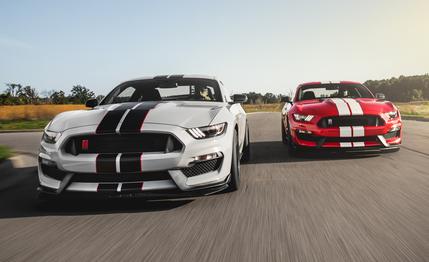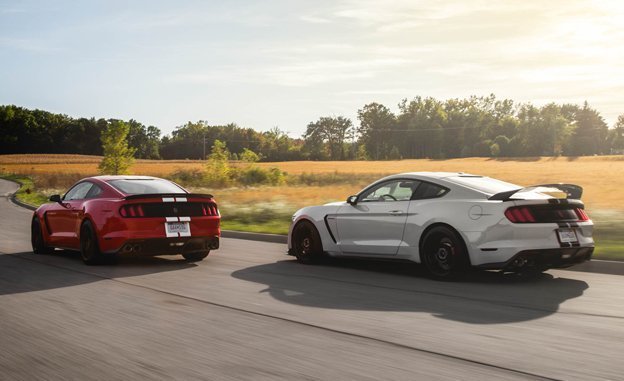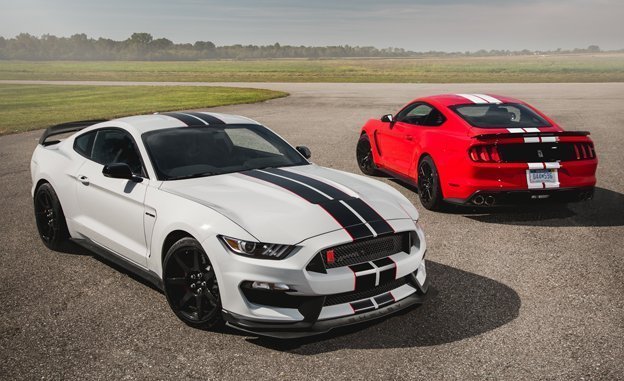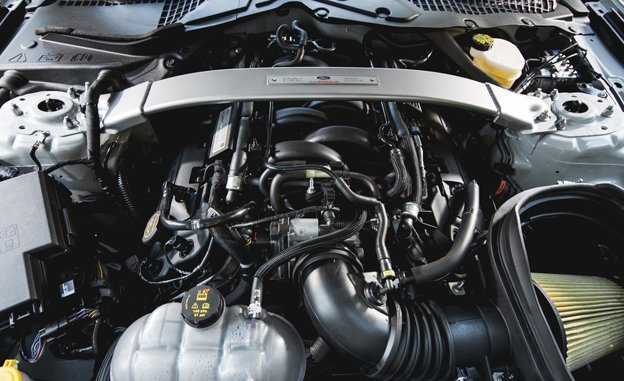
 Instrumented Test
Instrumented Test
We’ve been here before. We’ve stared down the barrel of a twin-striped Mustang with more than 500 horsepower and the name of a Texas chicken farmer across its fanny. The last one, the 2013 Shelby GT500, had 662 horsepower, in fact, and was said to go over 200 mph. It didn’t, not for us, anyway. Even so, it was what a Shelby Mustang should be, what it has been for decades: a hot quarter-mile with a side of smoky burnout. It was a muscle car with more. Mustang lovers got sweaty, but as usual, the rest of the auto world just shrugged and moved on with evolution.
Ford says it’s different this time. It says the new Shelby GT350, a name positively gestational with history, is a light-year leap in sophistication and handling. It says the flat-plane-crank V-8 delivers 8000 revelations per minute, that the magnetic suspension and custom, cross-drilled brake system and Michelin superstick tires prove that the company is serious about achieving world-class handling.
Well, Ford says a lot of things.
Our natural skepticism, honed to a katana’s twinkle by years of Shelbys with skull-rattling rides and plodding dynamics, marched proudly into the cockpit of the new GT350—whereupon it died instantly on the car’s red start button. Vaa-ROOOOOMpapapapapapa!!!!
Oh. Maybe they’re serious this time.


With the six-speed slotted into gear and the surprisingly light clutch lifted, the GT350 leapt onto the asphalt of Monterey’s Mazda Raceway Laguna Seca. First corner and first impressions: tight, tied-down, stable, maybe a little bit of push but, hey, the car’s cold and a bit heavy. Wind it out—wait, where’s the redline? Nowhere. It doesn’t exist! The sucker just keeps straining, keeps revving, keeps swelling with a glorious brassy, unmuffled, rhapsodic roar.
The anticipated upshift was forgotten as another corner approached.
The brakes—oof, such brakes!—chomp down, but the nose doesn’t dive. The car isn’t crossed up or squirming, it’s flat and stable and ready to turn right now! Less understeer this time, a perfect arc scribed from the white line to apex to white line. And it’s on the gas again, the sound flooding back—that addictive, dazzling, erotic exhale of lyric fire.
Yes. Yes, indeed. Ford is serious.
With the $49,995 GT350 and the even more track-ratty $63,495 GT350R, Ford wants to quit the pony-car sphere that the Mustang has inhabited since 1964. Supposedly using Carroll Shelby’s original race-ready Shelby GT350 as its guiding Polaris, the engineers set out to build a no-excuses track machine, more multitalented than the GT500 blunderbuss it replaces. That car was all about muscle power and 200 mph. This one is a little lighter, a lot more lithe, and perhaps able to finally get the attention of non-muscle-car types. You say you have a BMW but want something different, possibly American-made, but a Corvette isn’t your thing and a Camaro Z/28 is too brutish? Ford wants to talk to you.


Not that the new Shelby isn’t quick, but it’s not a dedicated quarter-mile eater, either. The base GT350 reaches 60 mph in 4.3 seconds after a somewhat difficult launch and does the quarter-mile in 12.5 seconds at 117 mph. Perhaps not stunning numbers these days, but the test car did weigh 3796 pounds. With its 18-pound carbon-fiber wheels and stickier Pilot Sport Cup 2 tires, the R (at 3710 pounds) makes it to 60 in 3.9 seconds and through the quarter-mile in 12.2 seconds at 119 mph. Guess what? Porsche 911 GT3 drivers don’t jump up and down about drag-strip times. Stats that matter to them more are skidpad grip and braking distances. There, the 350 and 350R pull 0.98 g and a startling 1.10 g, while stopping from 70 mph in 152 feet and 146 feet. Ford’s priorities become clear when you check the track-sheet data.
In the grander scheme, this is part of the internationalization of Ford’s U.S. product line in general, from Fiestas to Transits. Today’s auto-industry economics demand that you play on a world stage, which in a sporty car means world-class dynamics. The Mustang can no longer be just an island of romantic longing for drag-strip Christmas trees and fluorescent-lit drive-ins.
Okay, yes, the GT350 is North America–only for the time being, but its mien and manners are more BMW M4 than typical monster Mustang, even if the tire-shredding line-lock feature carries over into the Shelby. Really, the Cadillac ATS-V coupe, so enriched and able, is a better comparison to the GT350 than what seems to be its natural domestic competitor, the outgoing Chevrolet Camaro Z/28.


Well, the Cad is a good comparison except for the Shelby’s oddly unique V-8. We’ve complained about turbo engines and their lack of character. You want an engine with character? The GT350’s “Voodoo” V-8 is Brad Pitt, the Terminator, and James Bond coming at you with matching wry grins.
Everybody wants to know first what this 5.2-liter, 526-hp engine sounds like. Even when making its full 92-decibel war cry, it’s not a loping boom-boom like we’re used to from a muscle car, but rather a faster, more syncopated thrum that is more like what you hear from a Ferrari. Still, it doesn’t sound like a Ferrari, mainly because it doesn’t breathe like a Ferrari.
In case you’ve missed our many prior memos on the subject, here is a highly condensed update: This is a slightly bored and stroked version of the Mustang GT’s 5.0-liter V-8 but with a flat-plane crankshaft, meaning the connecting-rod journals are 180-degrees out, like in a Ferrari 458 or a Ferrari California, rather than at 90-degree intervals as on almost every other V-8 in production.
The Mustang does not wail like a Ferrari, however, because Ford’s engine is quite different. For one thing, it has a single intake and dual exhausts, as opposed to a dual intake and a single large muffler, as on a Ferrari. Also, rather than the Ferrari’s setup of, effectively, two four-cylinder engines joined at the crankshaft, where the center two pistons of each bank are 180 degrees out from the outer two, the Ford has a different arrangement. It puts each piston 180 out from the next one in line. This is mainly because Ford wanted a single large throttle body for better packaging and a power spread more befitting a Mustang.